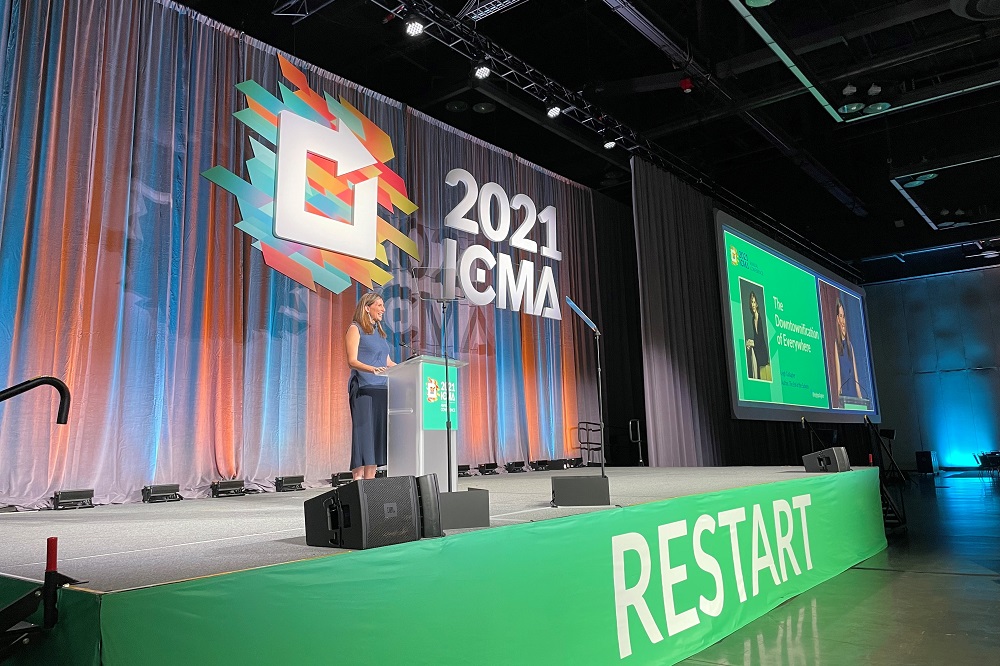
Leigh Gallagher— author of The End of the Suburbs, former Fortune editor, and director of external affairs at Google—began her Tuesday keynote address like so many other speakers this week: “What a year.”
She was referring specifically to the seismic shift we’re experiencing in how and where we want to live. There is growing dissatisfaction with—and movement away from—where we’ve lived for decades.
We’re seeing the urbanization or “downtown-ification” of America, and it’s also playing out all over the world. Despite the title of her book, The End of the Suburbs, the 'burbs aren’t necessarily going away—they’re radically changing.
First, she asked the audience to raise their hand if they had grown up and/or still live in a suburban area. The room was a sea of hands. Suburbs have been a huge part of American life for generations. But several years ago, Gallagher began noticing major changes in population growth. Cities were outpacing suburbs for the first time in 90 years. She decided to research the state of American suburbs—not just the data, but the emotion behind this migration. She said, “Every stone I turned over told me something big was happening.” She polled a lot of people who lived in the suburbs, and their sentiments sounded a lot alike:
- “I slowly realized it was not the life I wanted to lead.”
- “We’re only here until the kids are done with school.”
- “I live in a sterile, superficial suburb after having lived in Chelsea [New York City] for 12 years—and dying slowly, one day at a time.”
How did we get here? “Suburbs were a great idea when they were born,” said Gallagher. “But they have morphed into something else over time.” Residential planning became supersized and commoditized, which was only exacerbated by the housing boom.
Long Commutes
One of the problems that suburbs created was long commutes in heavy traffic. A lot of working parents move to the suburbs to focus on their children, but then they have to commute into the city for work, which takes away time from seeing their kids. Before the pandemic, more than three million Americans had commutes of more than three hours a day.
A Lost Sense of Community
Many suburbs position families farther away from each other. Neighbors aren’t socializing like they would in closer proximity. Gallagher told of the advent of “Trunk or Treat,” a suburban solution for trick-or-treaters not being able to walk from house to house in neighborhoods with homes spread so far apart. Families in suburban areas have begun convening in parking lots on Halloween so that children can easily collect candy from cars parked close together. Gallagher remarked, “What does that say about a community that has to create a separate community out of cars in a parking lot?”
Developers Taking Notice
Developers are trying to address this and have increasingly been adding urban features to suburban areas, ending up with something Gallagher coined “urban burgs.” Residents enjoy the feel of a downtown area without having to go to an actual downtown in the big city. Two spots where this has been especially successful are Gaithersburg, Maryland; and the Bridge Street District in Dublin, Ohio.
Gallagher mentioned that Toll Brothers, a leading builder in luxury homes, is shifting their portfolio along with the changing suburban trend, claiming that big McMansions only make up 50 percent of their business now. In a move toward developments with a more urban feel, their designs sometimes include intentional cracks in the concrete and edgy street murals to replicate a city experience.
Big Business
“To really see what’s happening, follow big business,” Gallagher said, showing photos of large retailers who have created smaller versions of their big-box stores for these new urbanized areas. Large corporations are also rethinking their giant headquarters campuses in the middle of nowhere—they want to be where the young talent is. As director of external affairs for Google, Gallagher reported that Google believes that the future of work will be flexible, but the office will still be an important part of that future. “Google is very much still investing in offices around the world. They believe great talent can be found anywhere, but especially in dense markets.” And leadership strongly believes in having the capability for their workforce to come together.
The Pandemic
How did Covid affect all of this? “The pandemic has only accelerated all of these trends," she said. Many city dwellers finally felt empowered to move into urban burgs. Towns are thinking more seriously about walkability and blended retail and residential space.
The American Dream Reimagined
Long story short: “We’ve already reached peak 'burb,” said Gallagher. “The binary choice of city or cul-de-sac is being replaced by a whole range of options in between—a choose-your-own-adventure kind of living.”
“It’s not so much the end of anything, but the beginning of something new and exciting. I believe these changes are among the most important to hit our landscape in decades. Even better than the original concept of the American dream, this is people prioritizing quality of life, affordability, and community.”
It isn’t too late to register for #ICMA2021 — Go Digital!
Gain full digital access to keynote and trailblazer speakers, 100+ dynamic sessions, 20+ livestreamed sessions, and conversation huddles through December 31. Register today!
New, Reduced Membership Dues
A new, reduced dues rate is available for CAOs/ACAOs, along with additional discounts for those in smaller communities, has been implemented. Learn more and be sure to join or renew today!
